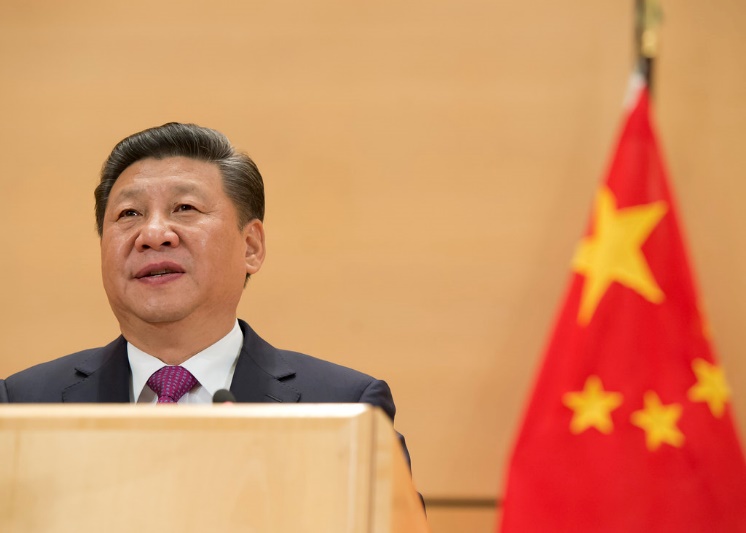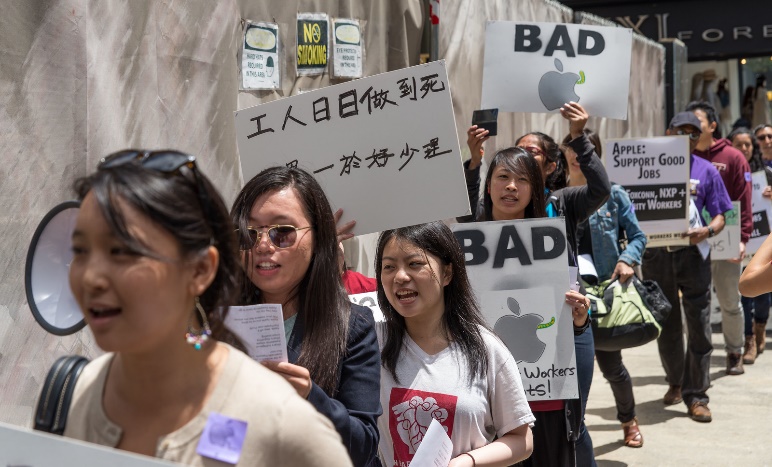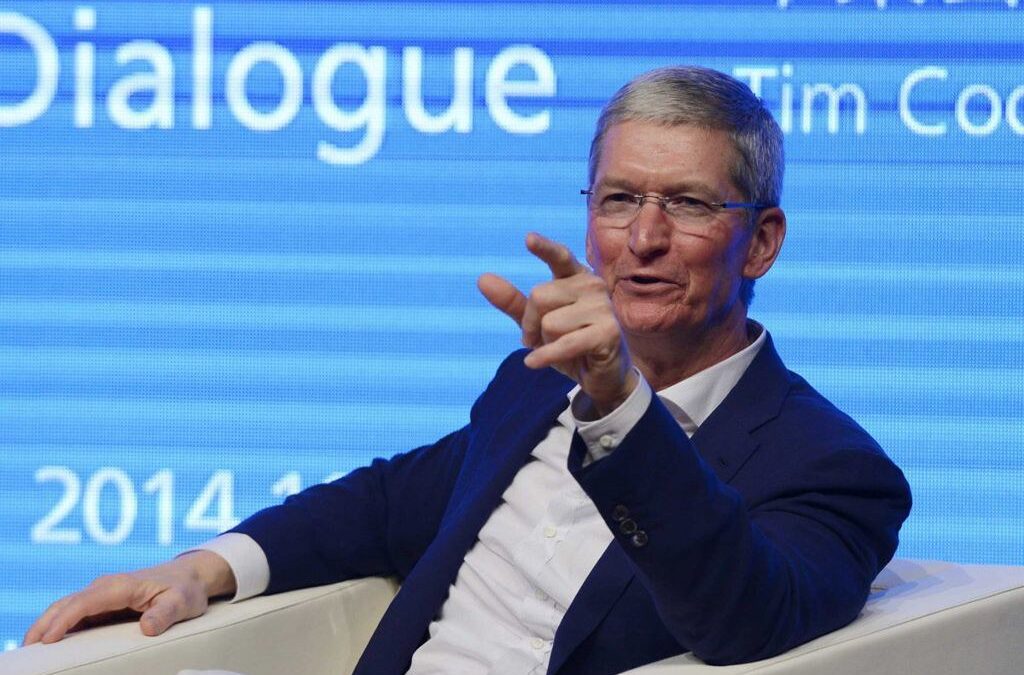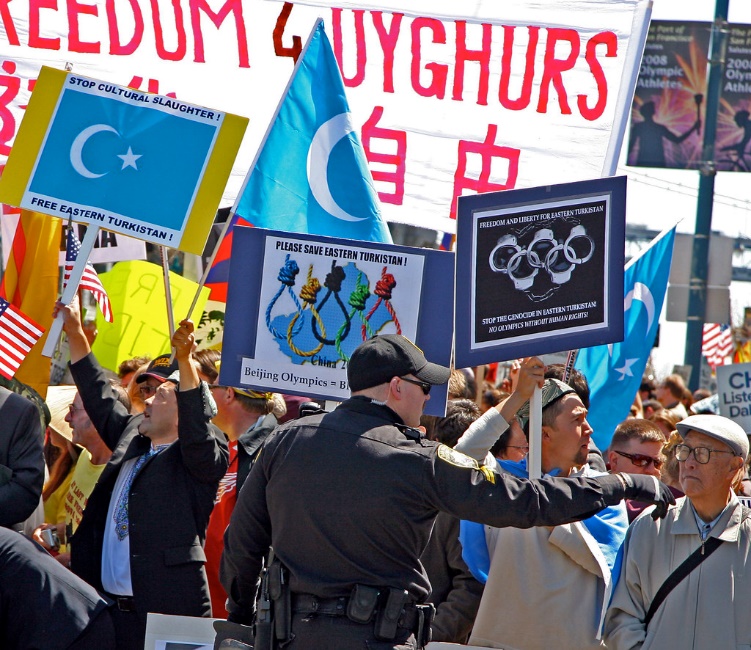United States Securities and Exchange Commission
Washington, D.C. 20549
NOTICE OF EXEMPT SOLICITATION
Pursuant to Rule 14a-103
Name of the Registrant: Apple Inc.
Name of persons relying on exemption: National Legal and Policy Center
Address of persons relying on exemption: 107 Park Washington Court, Falls Church, VA 22046
Written materials are submitted pursuant to Rule 14a-6(g) (1) promulgated under the Securities Exchange Act of 1934. Submission is not required of this filer under the terms of the Rule but is made voluntarily in the interest of public disclosure and consideration of these important issues.

PROXY MEMORANDUM
TO: Shareholders of Apple Inc.
RE: The case for voting YES on Shareholder Proposal No. 6 on the 2023 Proxy Ballot (“Communist China Audit”)
This is not a solicitation of authority to vote your proxy. Please DO NOT send us your proxy card; National Legal and Policy Center is not able to vote your proxies, nor does this communication contemplate such an event. NLPC urges shareholders to vote for Proposal No. 6 following the instructions provided on management's proxy mailing.
The following information should not be construed as investment advice.
National Legal and Policy Center (“NLPC”) urges shareholders to vote YES on Proposal No. 6, which it sponsors, on the 2023 proxy ballot of Apple Inc. (“Apple” or the “Company”). The Resolved clause states:
Shareholders request that, beginning in 2023, Apple Inc. report annually to shareholders on the nature and extent to which corporate operations depend on, and are vulnerable to, Communist China, which is a serial human rights violator, a geopolitical threat, and an adversary to the United States. The report should exclude confidential business information but provide shareholders with a sense of the Company’s reliance on activities conducted within, and under control of, the Communist Chinese government.
This report is necessary for Apple shareholders because:
1.Doing business with Communist China presents a unique, substantial, and pressing risk that warrants dedicated reporting.
2.The potential damage from Apple’s reliance on Communist China affects every aspect of its business. These China-specific risks should be assessed and reported more comprehensively.
3.Existing disclosures are fragmented, incomplete, and vague. As a result, these disclosures are inadequate to assess business risks related to Communist China.
Doing business with Communist China presents a unique, substantial, and pressing risk that warrants dedicated reporting.
China poses a unique challenge given its size, strength, and track record of constricting the freedom of its people and abusing their human rights. |
|
|
|
| |
Against this backdrop, it’s unrealistic and irresponsible for Apple to contend that doing business with China is comparable to other business risks disclosed in existing reports and filings – especially given Apple’s dependence on China for revenue and supply. |
| |
|
| |
To summarize the many challenges posed by Communist China: |
|
China is the second-largest country in the world by nominal GDP,1 and the largest country in the world by GDP in purchasing power parity (PPP).2
The nation of China is ruled by the Chinese Communist Party (CCP), whose stated intention is to “become a global leader in terms of composite national strength and international influence.” 3
What makes China’s size and emerging strength particularly troubling is that it is ruled by an authoritarian regime that abuses its own people and antagonizes its adversaries – including the United States. This includes:
Human Trafficking and Oppression of Ethnic Minorities: The U.S. State Department’s 2022 Trafficking in Persons Report declared China a state sponsor of human trafficking, noting that,
1 https://data.worldbank.org/indicator/NY.GDP.MKTP.CD?most_recent_value_desc=true&view=map
2 https://www.cia.gov/the-world-factbook/field/real-gdp-purchasing-power-parity/country-comparison
3 http://www.chinadaily.com.cn/china/19thcpcnationalcongress/2017-11/04/content_34115212.htm
“there was a government policy or pattern of widespread forced labor, including through the continued mass arbitrary detention of Uyghurs, ethnic Kazakhs, ethnic Kyrgyz, and members of other Turkic and/or Muslim minority groups in the Xinjiang Uyghur Autonomous Region (Xinjiang) under the guise of ‘vocational training’ and ‘deradicalization.’ Authorities continued to implement these policies in other provinces; targeted other religious minorities under their auspices; and sought the coerced repatriation and internment of religious and ethnic minorities living abroad through the use of surveillance, harassment, threats against them and their family members, and extradition requests.”4
|
|
| Since many companies in China are ultimately under the control of the CCP, they are – voluntarily or involuntarily – complicit in this human trafficking and oppression. |
|
| ||
| Cyber Warfare: The U.S. Cybersecurity and Infrastructure Security Agency states that the CCP “engages in malicious cyber activities to pursue its national interests. | ||
| Malicious cyber activities attributed to the Chinese government targeted, and continue to target, a variety of industries and organizations in the United States.”5 | ||
Escalating Military Threats: According to the U.S. Department of Defense, China now has the largest number of naval vessels of any military in the world; 975,000 active-duty military personnel, long-range precision strike systems, and hypersonic weapons. The 2022 China Military Power Report states that China’s “evolving capabilities and concepts continue to strengthen the PLA’s [People’s Liberation Army] ability to ‘fight and win wars’ against a ‘strong enemy’ (a euphemism likely for the United States), counter an intervention by a third party in a conflict along the PRC’s periphery, and project power globally.”6
China has recently demonstrated its intention to project power by repeatedly conducting military operations around Taiwan7 and sending large numbers of fighter jets into Taiwan’s Air Defense Zone.8 In regards to Taiwan, China’s ruler Xi Jinping has previously said, “The historical task of the complete reunification of the motherland must be fulfilled, and will definitely be fulfilled.”9 China is embarking on efforts to fully modernize its military by 2027, which according to the
4 https://www.state.gov/wp-content/uploads/2022/04/337308-2022-TIP-REPORT-inaccessible.pdf
https://www.dol.gov/agencies/ilab/against-their-will-the-situation-in-xinjiang
5 https://www.cisa.gov/uscert/china
6 https://media.defense.gov/2022/Nov/29/2003122279/-1/-1/1/2022-MILITARY-AND-SECURITY-DEVELOPMENTS-INVOLVING-THE-PEOPLES-REPUBLIC-OF-CHINA.PDF
7 https://www.ibtimes.com/taiwan-intercepts-9-pla-military-aircraft-4-naval-ships-tensions-mount-china-3660368
8 https://www.cnn.com/2022/12/25/asia/taiwan-china-aircraft-incursions-intl-hnk/index.html
9 https://www.cnbc.com/2021/10/09/china-president-xi-jinping-on-reunification-with-taiwan.html
U.S. Department of Defense, “could give the PLA capabilities to be a more credible military tool for the Chinese Communist Party to wield as it pursues Taiwan unification.”10
In addition to the above issues, Communist China presents other challenges, such as:
·The CCP’s crackdown on freedoms in Hong Kong.11
·The CCP’s “social credit” system, which monitors and punishes citizens – without due process – for certain behaviors, leading to potential blacklisting from travel, buying property, or taking out loans.12
·The CCP’s monitoring and control of the Internet in China, which prevents citizens from having open access to uncensored information.13
| · | Inhumane lockdowns of entire cities due to the CCP’s regressive Zero COVID policy.14 |
|
|
| · | The CCP’s abusive trade practices15 meant to dominate key U.S. industries.16 |
| |
| · | The CCP’s wrongful detainment of U.S. citizens.17 |
| |
| · | The CCP’s direct contribution to the fentanyl crisis that is destroying U.S. communities.18 |
|
It’s obvious that doing business with such an oppressive and hostile regime has significant risks that must be accounted for and mitigated. Any number of diplomatic, economic, or military events could trigger Apple to be cut off from both revenue and supply from China.
Shareholders deserve a report focused specifically on the nature and extent to which corporate operations depend on and are vulnerable to Communist China.
Existing reports and filings are not transparent or specific enough to address these concerns.
10 https://media.defense.gov/2022/Nov/29/2003122279/-1/-1/1/2022-MILITARY-AND-SECURITY-DEVELOPMENTS-INVOLVING-THE-PEOPLES-REPUBLIC-OF-CHINA.PDF
11 https://www.cfr.org/backgrounder/hong-kong-freedoms-democracy-protests-china-crackdown
12 https://www.nytimes.com/2019/12/17/technology/china-surveillance.html
13 https://hir.harvard.edu/building-the-fire-wall/
14 https://www.cnn.com/2022/09/05/china/china-covid-lockdown-74-cities-intl-hnk/index.html
15 https://www.rubio.senate.gov/public/_cache/files/a312bb80-3195-4837-ab5d-b0db1c63a670/AFBFFB4AC8C6D94F89D83A1F55095554.01.31.22-smr-letter-to-secretaries-blinken-and-yellen-re-china-trips.pdf
16 https://enforcement.trade.gov/download/factsheets/factsheet-prc-steel-racks-ad-cvd-final-071819.pdf
17 https://www.politico.com/news/2022/06/19/families-biden-administration-americans-china-00040706
18 https://finance.yahoo.com/news/chinas-role-in-the-us-fentanyl-epidemic-152338423.html
The potential damage from Apple’s reliance on Communist China affects every aspect of its business. These China-specific risks should be assessed and reported more comprehensively.
While Apple generically discusses business risks in its mandatory 10K filing, the risks specific to China should be addressed in more detail. The magnitude of China risk is not comparable to the general business risks disclosed by Apple, many of which are indistinguishable from the disclosures made by other public companies. China risk reaches every part of Apple’s business, including:
Revenue risk
·Greater China is Apple’s third-largest sales market, behind the U.S. and Europe.19
·With $74.2 billion in sales representing almost 20 percent of global revenue, it appears that Apple is overly dependent on this single, higher-risk market.
·A regional conflict over Taiwan could disrupt or eliminate this revenue, as well as $25.9 billion in revenue from Japan and $29.3 billion in revenue from the rest of Asia Pacific. This represents 32 percent of Apple's revenue for the twelve months ending September 2022.
·Russia’s invasion of Ukraine in early 2022 provides recent evidence of how damaging a regional conflict can be. The loss of human life and the need for humanitarian assistance are, of course, the foremost concerns. However, these events also provide recent evidence of how quickly a regional conflict can shut off revenue in the affected region. Boeing lost 90 jet orders.20 McDonald’s shut down 850 locations in Russia, where it derived 9 percent of its annual revenue.21 BP took a $24-billion write-down from exiting Russia.22
·Compared to the companies mentioned above, Apple’s reliance on China, Japan, and the rest of Asia Pacific is substantially larger as a percentage of overall revenue. Apple’s vulnerability to disruption from Communist China’s stated goal of “reunification” with Taiwan requires immediate and transparent analysis.
·The effects of regional conflict stemming from China’s hostility toward Taiwan would likely have ripple effects on the global economy, further damaging Apple’s business.
·According to a Federal Reserve report on the effects of war in Ukraine, “The increased geopolitical risks induced by the Russian invasion of Ukraine will weigh adversely on global economic conditions throughout 2022. Such effects are estimated in our model to reduce GDP and boost inflation significantly, exacerbating the policy trade-offs facing central banks around the world.”23
·It’s likely that an invasion of Taiwan would cause even more damage to the global economy, especially given the world’s reliance on semiconductors from Taiwan.24
19 https://www.apple.com/newsroom/pdfs/FY22_Q4_Consolidated_Financial_Statements.pdf
20 https://www.cnn.com/2022/04/12/business/boeing-lost-orders/index.html
21 https://www.kiplinger.com/investing/stocks/604317/companies-pulled-out-of-russia
22 https://www.reuters.com/business/energy/bp-boosts-buybacks-profit-soars-highest-over-decade-2022-05-03/
23 https://www.federalreserve.gov/econres/notes/feds-notes/the-effect-of-the-war-in-ukraine-on-global-activity-and-inflation-20220527.html
24 https://www.cnbc.com/2021/03/16/2-charts-show-how-much-the-world-depends-on-taiwan-for-semiconductors.html
Supply risk
Potential supply chain disruption represents an even greater business risk – one that could cut off the majority of Apple’s revenue:
·Of Apple's top 200 suppliers, almost half are located in China (including Hong Kong) and Taiwan.25 This supplier count does not reflect the relative size of each supplier, which paints a more troubling picture.
·JPMorgan estimates that 95 percent of Apple products are manufactured in China (including Hong Kong) and Taiwan.26 Using these estimates, a regional conflict, trade disputes, and other disruptions could affect nearly 100 percent of Apple’s product revenue.
| · | Supply chain costs related to the CCP’s Zero COVID policy, and the resulting protests, are estimated by Bloomberg to be over $40 billion as of December 2022.27 | ||
| · | Apple is clearly aware of risks to its supply chain. On Apple’s Q3 2022 earnings call, CEO Tim Cook said, “when the COVID restrictions hit in the Shanghai corridor, we lost the primary source of supply for Mac units. And that was either running at a reduced rate or down completely for the majority of the quarter. |
|
|
|
| And so it was a very big impact to the Mac business.”28 | ||
25 https://asia.nikkei.com/Business/China-tech/China-ousts-Taiwan-as-Apple-s-biggest-source-of-suppliers
26 https://www.reuters.com/technology/apple-may-move-quarter-iphone-production-india-by-2025-jpm-2022-09-21/
27 https://www.bloomberg.com/opinion/articles/2022-11-29/apple-s-iphone-covid-costs-keep-rising-after-china-factory-disruptions?leadSource=uverify%20wall
28 https://seekingalpha.com/article/4527231-apple-inc-aapl-ceo-tim-cook-on-q3-2022-results-earnings-call-transcript
·JPMorgan estimates that 25 percent of Apple products may be manufactured in India by 2025. Other reports indicate that Apple is accelerating plans to reduce its reliance on supply from China and Taiwan,29 including moving some production to Vietnam.30
·These are promising trends – if these analyses are correct. However, shareholders should not have to rely on a combination of equity analysts, think tanks, and supply chain consultants to determine Apple’s exposure to China-related supply chain risk.
·These risks should be transparently reported by Apple in enough specificity for shareholders to assess Apple’s vulnerability to these risks, as well as its intentions to mitigate them.
Reputational and Legal Risk
According to Forbes, Apple is the world’s most valuable brand, worth an estimated $241 billion.31 Apple’s brand is arguably the most important asset completely under its control. There is also a clear correlation between brand value and firm valuation. Reputational risks can damage a brand’s value – sometimes beyond repair.
Reputational risks from doing business with Communist China are relevant to shareholders, especially since the CCP’s actions so often conflict with Apple’s stated values and policies.
Privacy
·Apple’s website says, “Privacy is a fundamental human right. It’s also one of our core values. Which is why we design our products and services to protect it. That’s the kind of innovation we believe in.”32
·Apple’s 2023 Proxy Statement says, “At Apple, our North Star is creating great technology that empowers our customers and enriches their lives.”33
·Both of these statements conflict with the reality that Apple derives almost 20 percent of its revenue and 95 percent of its supply from a country that runs a massive surveillance program on over one billion citizens.
·The CCP tracks its citizens using facial recognition34 and monitoring of social media posts.35 They punish citizens using a “social credit” system that can cast out citizens from access to jobs, housing, and travel with no due process.36 They monitor movements and suppress dissent using QR codes.37
29 https://www.wsj.com/articles/apple-china-factory-protests-foxconn-manufacturing-production-supply-chain-11670023099
30 https://www.forbes.com/sites/qai/2023/01/01/apple-to-diversify-its-supply-chain-by-producing-macbooks-in-vietnam/?sh=40a2aac37d75
31 https://www.forbes.com/the-worlds-most-valuable-brands/#1867ff74119c
32 https://www.apple.com/privacy/
33 https://s2.q4cdn.com/470004039/files/doc_financials/2023/Proxy_Statement_2023.pdf
34 https://www.businessinsider.com/how-china-is-watching-its-citizens-in-a-modern-surveillance-state-2018-4?op=1
35 https://www.nytimes.com/2019/12/17/technology/china-surveillance.html
36 https://www.wired.co.uk/article/china-social-credit-system-explained
37 https://www.cnn.com/2022/06/15/china/china-zhengzhou-bank-fraud-health-code-protest-intl-hnk/index.html
·While Apple can’t be blamed for the CCP’s surveillance of consumer devices, it can be held accountable for whether its technology is empowering customers or the CCP.
·Tim Cook is aware of the dangers of technology surveillance. At a privacy conference in Brussels in 2018, he said, “Our own information, from the everyday to the deeply personal, is being weaponized against us with military efficiency.”38 There is no greater example of this than the Chinese military’s use of technology surveillance against its citizens in China and around the world.
Human rights and free expression
Apple’s 2023 Proxy Statement says, “Our commitment to human rights extends to every facet of our business, from working to safeguard security and user privacy in our products and promoting freedom of expression and access to information on our platforms to providing a safe and respectful environment for all people in our supply chain.”39
This statement conflicts with Apple’s behaviors in a number of ways:
| · | Apple, along with other large U.S. companies, lobbied against the Uyghur Forced Labor Prevention Act reportedly because of the difficulty of compliance.40 If Apple is unable to prove there is no forced labor in their supply chain – either due to lack of visibility or lack of documentation – then they cannot claim to have adequately addressed this issue. |
|
|
| · | Apple removed an app in 2019 that was used by pro-democracy protestors in Hong Kong.41 |
|
·An iPhone update in November 2022 limited AirDrop file sharing in China during the anti-COVID protests of 2022.42 Apple claimed the AirDrop updates were being rolled out globally. However, this would make the update’s appearance in China only while the CCP was cracking down on widespread protests an incredible coincidence.43
38 https://time.com/5433499/tim-cook-apple-data-privacy/
39 https://s2.q4cdn.com/470004039/files/doc_financials/2023/Proxy_Statement_2023.pdf
40 https://www.nytimes.com/2020/11/29/business/economy/nike-coca-cola-xinjiang-forced-labor-bill.html
41 https://www.nytimes.com/2019/10/09/technology/apple-hong-kong-app.html
42 https://www.theguardian.com/world/2022/nov/11/apple-limits-iphone-filesharing-feature-used-by-protesters-in-china
43 https://techcrunch.com/2022/11/09/apple-limits-airdrop-everyone-option-to-10-minutes-in-china/
Legal risks
Public awareness continues to increase around important issues such as human rights abuses in supply chains, data privacy protection, and threats posed by Communist China. In turn, this has led to regulatory initiatives intended to address these issues.
For example, on the topic of human rights abuses in supply chains, Apple is now subject to disclosures44 under the California Transparency in Supply Chains Act of 2010, the UK Modern Slavery Act of 2015, the Australian Commonwealth Modern Slavery Act of 2018,45 and the Uyghur Forced Labor Prevention Act of 2021.46 Germany has similar legislation going into effect in 2023. It’s reasonable to assume that additional countries will pass anti-slavery legislation in the coming years.
The disclosures required by these laws could subject Apple to legal risks stemming from misrepresentation or failure to mitigate slavery-related issues in the supply chain – as has already happened to Starbucks and Nestle.47 These risks are heightened given that 95 percent of Apple's supply reportedly comes from China, a state sponsor of human trafficking according to the U.S. State Department.
A company’s brand is a function of customer trust. When a company operates in direct violation of its stated values and policies, that trust can be broken and brand value damaged, in turn lowering the company’s market capitalization. Shareholders must have the ability to determine how Apple is specifically addressing the reputational and legal risks related to doing business with Communist China.
Existing disclosures are fragmented, incomplete, and vague. As a result, these disclosures are inadequate for assessing business risks related to Communist China.
Apple’s Statement of Opposition to Proposal No. 6 in their 2023 Proxy Statement is repeatedly vague and diversionary, further highlighting how existing disclosures on China risk are inadequate.
·To provide an example of “transparent reporting”, Apple’s 2023 Proxy Statement quotes a disclosure from its 10-K that says, “Substantially all of the Company’s manufacturing is performed in whole or in part by outsourcing partners located primarily in Asia, including China mainland, India, Japan, South Korea, Taiwan, and Vietnam.”48 This vague statement does not address the nature and extent of Apple’s exposure to China, which accounts for the vast majority of its supply.
44 https://www.apple.com/supplier-responsibility/pdf/Apple-Combat-Human-Trafficking-and-Slavery-in-Supply-Chain-2021.pdf
45 https://modernslaveryregister.gov.au/statements/file/29de05c3-87c0-4557-a5ae-b6a8ea26d74e/
46 https://www.cbp.gov/trade/forced-labor/UFLPA
47 https://www.mercurynews.com/2021/12/22/microsoft-apple-suppliers-exposed-in-australia-anti-slavery-law/
48 https://s2.q4cdn.com/470004039/files/doc_financials/2023/Proxy_Statement_2023.pdf
·To provide an example of “zero tolerance for forced labor,” Apple’s 2023 Proxy Statement says “In 2021, we conducted more than 1,100 assessments in 52 countries, and found no instances globally where anyone was forced to work.”49 This statement diverts entirely from the real questions, which are:
oHow many of the 1,100 assessments were completed in China?
oOf the assessments completed in China, what percent of factories were assessed, and what percent of spend do those factories represent for Apple’s supply chain?
oWhat percent of assessments were from beyond the first tier of Apple’s supply chain?
Without that information, it can’t be determined whether Apple even has true visibility into its supply chain in China.
·As another example of “zero tolerance for forced labor, Apple’s 2023 Proxy Statement says, “in preparation for the adoption of the Uyghur Forced Labor Prevention Act, we conducted due diligence on our supply chain and found no evidence that any of our suppliers were located in the Xinjiang Uyghur Autonomous Region or that any workers transferred from the region were working on Apple production lines.”50 This disclosure is so vague as to be meaningless. What does “due diligence” mean? The same questions mentioned in the previous bullet points apply here.
·Apple publishes a supplier list annually with the name and primary location where manufacturing for Apple occurs. A simple list of factories does not indicate the magnitude of spending associated with each factory, making it difficult to accurately assess Apple’s reliance on certain companies or regions in China.51 This, again, leaves it to outside analysts and supply chain consultants to assess supply chain risk when that information should come directly from Apple.
·SEC-mandated disclosures of material risks do not adequately assess the nature and extent of each of those risks, as requested by Shareholder Proposal No. 6.
·SEC-mandated disclosures of material risk do not address Apple’s initiatives to mitigate those risks. According to SEC’s Division of Enforcement, “It is critical that public companies accurately disclose material business risks and timely disclose and account for loss contingencies that can materially affect their bottom line."52 The disclosures Apple makes or refers to in its Statement of Opposition to Proposal No. 6 make no such accounting.
Based on Apple’s own statements, the information for a report on China-related risks should be readily available.
49 https://s2.q4cdn.com/470004039/files/doc_financials/2023/Proxy_Statement_2023.pdf
50 https://s2.q4cdn.com/470004039/files/doc_financials/2023/Proxy_Statement_2023.pdf
51 https://www.apple.com/supplier-responsibility/pdf/Apple-FY21-Supplier-List.pdf
52 https://www.sec.gov/news/press-release/2019-194
·Apple’s 2023 Proxy Statement mentions that “Apple has a strong enterprise risk management program that is designed to identify, assess, and monitor Apple’s significant business risks, including risks related to our supply chain and operations, which we have identified as a key area of focus.”53 As mentioned previously, the details required for shareholders to assess China-related risks do not appear in existing disclosures. If Apple is indeed assessing these business risks, then Apple’s Risk Oversight Committee should be able to supply the information needed for the proposed report.
·Apple’s 2021 Statement on Efforts to Combat Modern Slavery in Our Business and Supply Chains says, “The ESCI [Environmental and Supply Chain Innovation] team works across a number of business groups, teams, and functions, including, but not limited to, Apple’s Global Security Investigations and Child Safety team, Business Conduct and Global Compliance, Legal, Finance, Product Design, Procurement, Manufacturing Operations, Environment, and Retail. The teams regularly consult with Apple’s senior leadership to review progress and update ongoing strategies.”54 If this team has assessed risks across Apple’s business and updates senior leadership on progress, then the information needed for a report specifically on China-related risks should be readily available.
·Apple’s report called How We Work With Suppliers says, “We track and measure performance across a range of areas and we apply the lessons we learn to continually improve.”55 That tracking and measurement would presumably supply the data needed for a report specifically on China-related risks.
·Apple’s 2023 Proxy Statement says, “Apple’s Board is responsible for the oversight of significant risks affecting our business and Apple’s Enterprise Risk Management Program.”56 The Board’s ability to provide oversight presumably results from reporting on specific risks related to China – Apple’s third-largest market for revenue and largest supplier for their products.
If all of this risk assessment and reporting is already taking place, then compiling a report specific to China-related risks presents little additional burden while offering shareholders much-needed visibility to the nature and extent of these risks.
Conclusion
Doing business in and with Communist China poses unique risks for Apple, especially in light of the company’s reliance on China for revenue and supply. While Apple insists that existing disclosures and voluntary reports account for these risks, that is not the case. These disclosures
53 https://s2.q4cdn.com/470004039/files/doc_financials/2023/Proxy_Statement_2023.pdf
54 https://www.apple.com/supplier-responsibility/pdf/Apple-Combat-Human-Trafficking-and-Slavery-in-Supply-Chain-2021.pdf
55 https://www.apple.com/supplier-responsibility/pdf/How-We-Work-With-Suppliers.pdf
56 https://s2.q4cdn.com/470004039/files/doc_financials/2023/Proxy_Statement_2023.pdf
and reports are vague and do not address risks specific to doing business with China. The information is scattered among various reports, and meaningful information about Apple’s assessment and response to China-related risks is missing, leaving shareholders in the dark as to the extent and nature of this risk.
For this reason, we urge you to vote FOR Shareholder Proposal No. 6 on Apple’s 2023 Proxy requesting a report on the nature and extent to which Apple depends on and is vulnerable to doing business in and with Communist China.
Photo credits:
Page 2 – Xi Jinping/UN Geneva, Creative Commons
Page 3 – Apple protest/Annette Bernhardt, Creative Commons
Page 4 – COVID testing in China/QuantFoto, Creative Commons
Page 6 – Tim Cook/tuaulamac, Creative Commons
Page 8 – Freedom 4 Uyghurs protest/FitzClick, Creative Commons
THE FOREGOING INFORMATION MAY BE DISSEMINATED TO SHAREHOLDERS VIA TELEPHONE, U.S. MAIL, E-MAIL, CERTAIN WEBSITES AND CERTAIN SOCIAL MEDIA VENUES, AND SHOULD NOT BE CONSTRUED AS INVESTMENT ADVICE OR AS A SOLICITATION OF AUTHORITY TO VOTE YOUR PROXY.
THE COST OF DISSEMINATING THE FOREGOING INFORMATION TO SHAREHOLDERS IS BEING BORNE ENTIRELY BY THE FILERS.
PROXY CARDS WILL NOT BE ACCEPTED BY US. PLEASE DO NOT SEND YOUR PROXY TO US. TO VOTE YOUR PROXY, PLEASE FOLLOW THE INSTRUCTIONS ON YOUR PROXY CARD.
For questions regarding Apple Inc. – Proposal #6 – the Shareholder Proposal Requesting the Board of Directors to Annually Prepare a “Communist China Audit” report, submitted by National Legal and Policy Center, please contact Paul Chesser, director of NLPC’s Corporate Integrity Project, via email at pchesser@nlpc.org.




